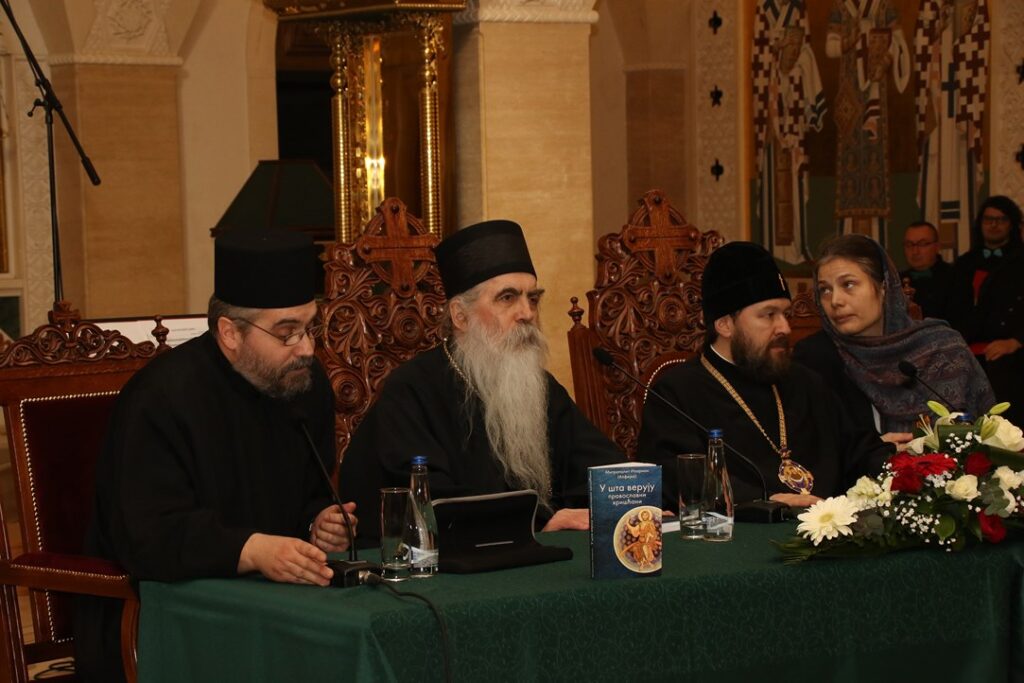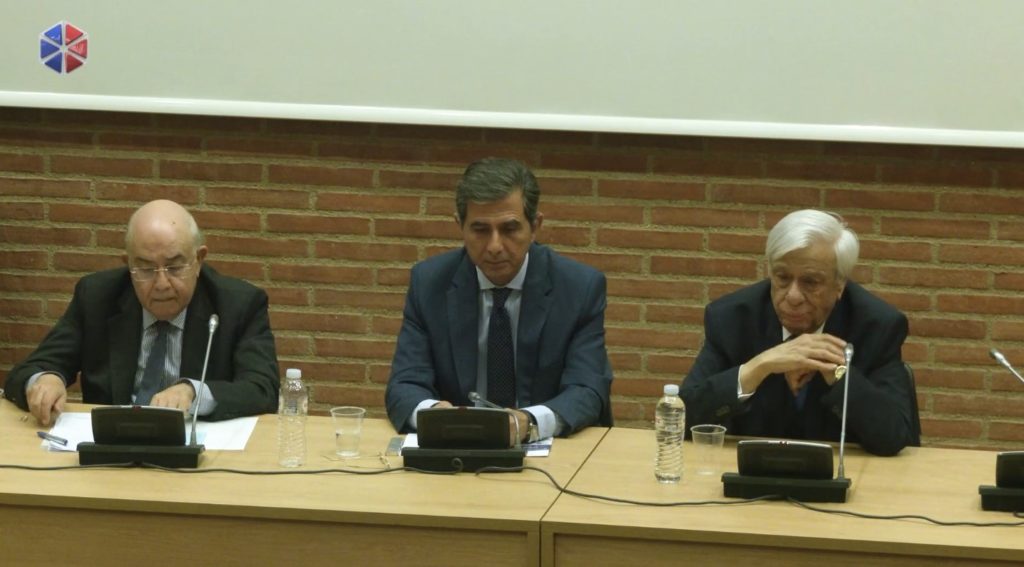Serbian version of Metropolitan Hilarion’s book presented in Belgrade

On 17 February 2020, the presentation of the Serbian version of Metropolitan Hilarion of Volokolamsk’s book “What Orthodox Christians Believe In” took place at the crypt of the St. Sava Cathedral in Belgrade.
The translation was made by Bishop Antonije of Moravici, rector of the Moscow Representation of the Serbian Orthodox Church and published in December 2019.
In his remarks, Bishop Irenej of Bac said in particular that “from the pages of his book, the author talks with the reader in a language understandable to modern well-educated young man” and this makes the book “a step forward as compared to previous experiences of compiling catechises”. He thanked Metropolitan Hilarion for his inspiring work offering a concentrated, eligible, intelligible and theologically authentic exposition of the truths of Orthodoxy.
Rev. Prof Zoran Devrnja, University of Belgrade department of Orthodox theology, introduced the gathering to the content of the book focusing on its missionary and catechetical importance and the significance of its publication in Serbian version.
Present at the event were bishops and priests of the Serbian Orthodox Church, professors and students of the University of Belgrade, and people interested in theological and catechetical issues.
Addressing the gathering, Metropolitan Hilarion said, ‘Thanks to the blessing of His Holiness Patriarch Kirill and the invitation of His Holiness Patriarch Irenaeus, I have a great joy to visit the Serbian land so dear to me.
‘Before this presentation, I had an opportunity to see in every detail the progress of the work carried out in the upper church where our remarkable Russian masters of mosaic are working. I went up in a building lift to see the cupola, the under-cupola space and the spandrels. I happened to take part in various construction, restoration and painting works and tried never to lose an opportunity to go up to the top, because after the scaffolds are removed, you will see what is there on top only from below and will miss all the thoroughness with which mosaicists work laying every stone properly.
‘I remember how we initiated this project, how difficult it was to find masters for realising such a grandiose initiative, how difficult it was in the beginning to find funds. Honestly speaking, I thought the implementation of this project would take about thirty years, but now I have seen that the mosaic work is already close to completion. I was very pleased by the fact that soon we will see this magnificent cathedral well-arranged and well-adorned not only on the outside but also inside. It will be not only an outstanding monument of Christian architecture but also an outstanding monument of Christian representational art. Built for the glory of God, it will praise God by every small stone of its interior decoration.
‘I and glad that both the Russian Orthodox Church and the Russian State have made their contributions to the adornment of the magnificent St. Sava Cathedral and happy that I have had the honour to take part in this project.
‘Today, the Serbian Orthodox Church is going through a period of hard trials that have fallen to her lot in the neighbouring country – Montenegro. In some sense, a story is repeated in it today which happened in Ukraine a year earlier, where then president decided to create ‘a new church’. He fancied that he could create a Church by his own hands and that the creation of ‘a new church’ in Ukraine, independent of the Russian Orthodox Church, will help him in his pre-election struggle. This man suffered a landslide defeat at the elections but managed to do by his actions much harm to the Church.
‘Today, something similar is happening in Montenegro where the authorities have adopted a discriminatory law through which it may be possible in future to withdraw churches from the jurisdiction of the canonical Church and give it to anybody. The authorities broke ranks with their people and the people took to streets. In Montenegrin cities and villages, we see thousands and dozens of thousands of people who are coming out to support to their Church.
‘I would like to assure you all that in this noble and sacred struggle the Russian Orthodox Church will always be with the Serbian Orthodox Church.
‘I wish to all of us that the grave period of temptations, which has engulfed Orthodox Churches in various countries, may pass as soon as possible. First, these temptations began in the canonical space of the Russian Church but now they have spanned to the canonical space of the Serbian Church. Temporal rulers are seeking to rule church life and create a Church at their own discretion. But the Church has been created by the Lord God Himself, and the church people are her guardian. Precisely these people have taken to streets today.
‘I will not speak at length about the book presented today because Prof Zoran Devrnja has already specified its content, for which I am grateful to him. And my dear bother, His Grace Irenaeus, has spoken about the categories of readers who may find this book useful.
‘I cordially thank Bishop Antonije of Moravici, representative of the Serbian Orthodox Church to the Moscow Patriarchate, who initiated the publication of this work in the Serbian version and translated it.
‘The book What the Orthodox Christians Believe It is written not for specialists in theology but for a wide range of readers. I have written quite a lot of voluminous works intended precisely for theologians, but every time I undertake to write a book I first of all try to answer certain questions for my own self and never put to paper the thoughts which I have not fully sorted out. And even in the most complicated issues of theology, I seek to speak as simply as possible.
‘In the book presented today, I deal with fundamental dogmatic truths on which the Orthodox theology is built. When you tell to the modern man about dogmata, it seems to him that this word designates something dry, stiff, far away from him. I try to show in my book that dogmata is what the Church is based on. Just as the St. Sava Church stands on a gigantic foundation deeply dug into the soil, so the Church is based on dogmata. They can be not very visible but if this dogmatic foundation is lost, the whole building may crash down.
‘For those who do not know anything about dogmata it is very difficult to understand what the Church exists for and by what she lives. Our whole divine service, the Divine Liturgy, matins, vespers or other services are all filled with dogmatic truths, and if you are ignorant of them and do not love them, it is difficult for you to come to know and love the Orthodox divine service.
‘The dogmata themselves, as I prove in my book, are not some inventions of theologians, nor were they born in the heads of professors who kept sitting at their desks with pens, pencils or computers in their hands. Dogmata is what was primordially laid in very foundation and core of the Church. And it is the task of theologians in each epoch to formulate these dogmata, explain them and bring them home to people in a language intelligible for them.
‘Very often the dogmatic truths were formulated by the fathers of the Church in response to arising heresies. For instance, in the 4th and 5th centuries, there was a lot of debate about how the Divine and human nature are united in Jesus Christ. One of the theologians by name of Apollinarius in the 4th century put forward this theory: Jesus Christ had a human body but His soul and mind were Divine. Seemingly, what is harm in this explanation? But the sharp theological mind of St. Gregory the Theologian discerned a dangerous error in it. He said, how can it be that if Jesus Christ had no human soul and human mind, how then the salvation of human beings happened? And St. Gregory formulated the principle which was laid in the basis of Orthodox Christology and the whole Orthodox teaching on salvation: that which is not taken is not healed. If Christ took from us, human beings, the human body alone, while His soul, spirit and mind were Divine, it means that what He saved was the human body alone. No, Gregory the Theologian says, the Lord Jesus Christ took the whole human nature – body, mind and soul. Why is it important for us? – Because He assumed our human body, our mind and our soul, that is, the dogma has a direct bearing on our own destiny in eternity, on our salvation.
‘It is only one example but there are many. It is not always easy to explain all this to the modern man since he lives with quite different notions and thinks in different categories. Therefore, the task of a theologian in our time is to try to bring home to modern man the dogmatic truths formulated in old times doing it in such a way that he may not only understand them but also become inspired by them and come to love them.
‘I am convinced that Orthodox theology should be not only correct but also inspiring. Through my book I wanted to convey to readers at least a particle of the inspiration which I had felt not only when I was writing it but also when I came in touch with the dogmatic theology of the Orthodox Church through the writings of Holy Fathers. I hope that not only in Russia but also in Serbia this book will find its reader.
‘I wish to God’s help in your work and in your service. May the Lord preserve Serbia, the Serbian people and the Serbian Orthodox Church, and please know that Russia and the Russian Church is always with you’.
— Source: DECR Communication Service / mospat.ru
H αναδημοσίευση του παραπάνω άρθρου ή μέρους του επιτρέπεται μόνο αν αναφέρεται ως πηγή το ORTHODOXIANEWSAGENCY.GR με ενεργό σύνδεσμο στην εν λόγω καταχώρηση.
Ακολούθησε το ORTHODOXIANEWSAGENCY.gr στο Google News και μάθε πρώτος όλες τις ειδήσεις.


















